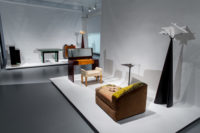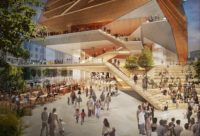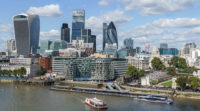When I got my first look at Zaryadye Park, it was still a construction site. Workers were rolling out the green carpet—pallets of unnaturally thick sod—for dignitaries who would attend the ribbon-cutting ceremony the next morning. But a few tourists (and this writer) had already found their way into the 32-acre park, which slopes down to the Moskva River just a few hundred feet from the Kremlin. My curiosity about the park was piqued not only by its architectural provenance—its lead designers are Diller Scofidio + Renfro, known for their role in creating New York’s High Line—but also by the fact that, nearly 30 years ago, I had stayed in the Rossiya Hotel, a Soviet behemoth that occupied the site until its demolition in 2006.
For a time, it looked like a mixed-use development by Foster + Partners would replace the Rossiya, but ultimately the powers that be decided to give park-starved Muscovites a bit of open space. Six teams, including West 8 and MVRDV, participated in a 2012 competition organized by Moscow’s forward-looking Strelka Institute. DS+R, working with Mary Margaret Jones of Hargreaves Associates, urban planners Citymakers and a number of consultants, many from outside the United States, presented a scheme that to this writer seemed overly ambitious; it called for zones replicating archetypal Russian landscapes—tundra, steppe, forest, and marsh—with high-tech features that would actually change weather patterns. But pie-in-the-sky proposals tend to entice juries—sometimes leaving competition winners wishing they hadn’t made so many promises.
That doesn’t seem to have happened here. The park may not change the weather, but it does change visitors’ perceptions of the weather, Renfro says. One pavilion contains a continuously replenished ice sculpture, meant to provide a year-round blast of winter. Far more prominent is the “crust”—a 15,000-square-foot glass canopy that surmounts a bulbous lawn on the roof of the park’s new concert hall. The idea is to create a bubble of summer twelve months a year through passive solar heating. (Although there are a few photovoltaic panels in the “crust,” most of the active solar features in the original design succumbed to value engineering.)
If the park is laden with ideas, its architectural crowd-pleasers are pretty self-explanatory. First among them is a boomerang-shaped concrete bridge that cantilevers 45 feet above the Moskva River. Sergey Kuznetsov, Moscow’s chief architect and an ardent proponent of the project, says he fought to keep the bridge when it was nearly derailed by cost and security concerns. Overall, Kuznetsov says, he spent five years fending off criticism that the park was too “ultra-modern,” or too American, for a site so close to Red Square. But on opening day, Zaryadye, though not entirely complete, seemed destined to become, in the words of Kuznetsov and many others, “the new symbol of Moscow." Even Vladimir Putin turned up for the ribbon-cutting, seemingly pronouncing the design Russian enough.
If Putin takes credit for the project—as seems likely, given his opening day appearance—that could taint its image abroad. But Renfro sees it as unassailably good that an American firm got to design the first major new park in Moscow in half a century. It was built at an estimated cost of $400 million and, according to the DS+R principals, pretty much to their specifications. (The general contractor, in an opening day address, confessed that the designers’ ideas “blew [her] mind.”)
Zaryadye’s closest equivalent isn’t the High Line, which DS+R designed with James Corner Field Operations, but Chicago’s Millennium Park. Like the 25-acre Chicago park, it isn’t particularly pastoral; thanks to the wealth of infrastructure that lies below, even the most natural bits are dotted with manhole covers and vents.
And then there are the larger interruptions, which make Zaryadye, frankly, orders of magnitude more ambitious than Millennium. A collection of historic buildings, including a cathedral, a monastery, and four churches, encircle "Z Park." Once obscured by the Rossiya, these old structures are now attractions. New construction includes a 1,500-seat concert hall by the Russian firm TPO Reserve (with acoustician Yasuhisa Toyota), plus restaurants, exhibitions spaces, and a "nature center" that are mostly below grade, behind cave-like facades designed by DS+R. A 400-car garage and a new Moscow history museum are fully underground. Together, the new structures total about half a million square feet.
Only about a third of the park’s planted surface rests on solid ground, according to landscape architect Jones. She says achieving sufficient soil depths was a constant concern, especially with vegetation varied enough to represent the four Russian typologies yet able to survive in Moscow. Throughout, gardens end not with hard edges but with but with “tongues” that penetrate the hardscape—part of the not-too-ordered aesthetic the designers describe as “wild urbanism.” The park’s tens of thousands of elongated hexagon pavers are all oriented the same way, which Jones says suggest a net being cast over the terrain.
The park isn’t as coherent an architectural statement as the High Line or Seattle’s Olympic Sculpture Park (by Weiss/Manfredi Architects), which zigzags down from that city to its waterfront. Zaryadye’s complex program and multiple authors made that level of consistency impossible. And yet in its way it is far more exciting than either of those public spaces, given its almost breathtakingly ambitious program, its historic setting, and its roots in international collaboration.
There’s one thing it surely has in common with the High Line: The public will love it. Opening day visitors, polite but enthusiastic, trampled some of the park’s vegetation and left litter outside the beautifully designed but narrow trash bins. For the new symbol of Moscow, maintenance will be as much of a concern as architecture.



















Post a comment to this article
Report Abusive Comment